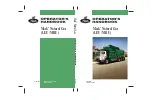
WARNING
Be sure no one ever rides in the upper
bunk. That person could be thrown out
in an accident and could be very seri-
ously injured. The upper bunk is not
equipped with a restraint system. DO
NOT use the upper bunk while you are
moving. Failure to comply may result
in death, personal injury, equipment or
property damage.
The sleeper restraint is stored in a
compartment on the rear sleeper cab wall.
on page 30,
for more information on cab/seat restraint
systems.
WARNING
Failure to properly use the sleeper re-
straint when an individual is located in
the sleeper bunk and the vehicle is
moving can result in death or personal
injury.
To Lower
Upper
Bunk
Pull on the lanyard in the upper left
corner of the bunk to release the bunk.
This will free it from the anchored
position and allow you to lower the bunk.
To Raise
Upper
Bunk
Fold the upper bunk up and push it
against the retaining latch until you hear
a click. Pull on the bunk to be sure it is
latched securely.
Upper Bunk Ladder Considerations
If your vehicle is equipped with the upper
bunk ladder, ensure that you follow the
safety tips as detailed in
on page 14.
Stopping the Vehicle
A hot engine stores a great amount of
heat. It doesn’t cool down immediately
after you shut it off. Always cool your
engine down before shutting it off. You will
greatly increase its service life.
Idle the engine at 1,000 rpm for five
minutes. Then low idle for 30 seconds
before shutdown. This will allow circulating
coolant and lubricating oil to carry away
heat from the cylinder head, valves,
pistons, cylinder liners, turbocharger, and
bearings. This way you can prevent
serious engine damage that may result
from uneven cooling.
Turbocharger
This cooling-down practice is especially
important on a turbocharged engine. The
turbocharger contains bearings and seals
that are subjected to hot exhaust gases.
While the engine is operating, heat is
carried away by circulating oil. If you stop
the engine suddenly, the temperature of
the turbocharger could rise as much as
100°F (55°C) above the temperature
reached during operation. A sudden rise in
temperature like this could cause the
bearings to seize or the oil seals to loosen.
Refueling
Air space in your fuel tanks allows water to
condense there. To prevent this
condensation while you are stopped, fill
your tanks to 95 percent of capacity. When
refueling, add approximately the same
amount to each fuel tank on vehicles with
more than one tank.
DRIVING - Stopping the Vehicle
Y53-6126-1A1 (01/21)
185
4
Содержание Peterbilt 567 2021
Страница 1: ...567 M O D E L ...
Страница 2: ......
Страница 3: ...Safety 1 Emergency 2 Controls 3 Driving 4 Maintenance 5 Information 6 Contents ...
Страница 5: ......
Страница 7: ...Daily Checks 35 Weekly Checks 36 Systems Check 37 SAFETY Y53 6126 1A1 01 21 5 1 ...
Страница 41: ...SAFETY Systems Check Y53 6126 1A1 01 21 39 1 ...
Страница 63: ...1 Additional Switches 2 Ignition Switch CONTROLS Instrument Cluster Y53 6126 1A1 01 21 61 3 ...
Страница 131: ...CONTROLS Cab Accessories Y53 6126 1A1 01 21 129 3 ...
Страница 331: ......






































